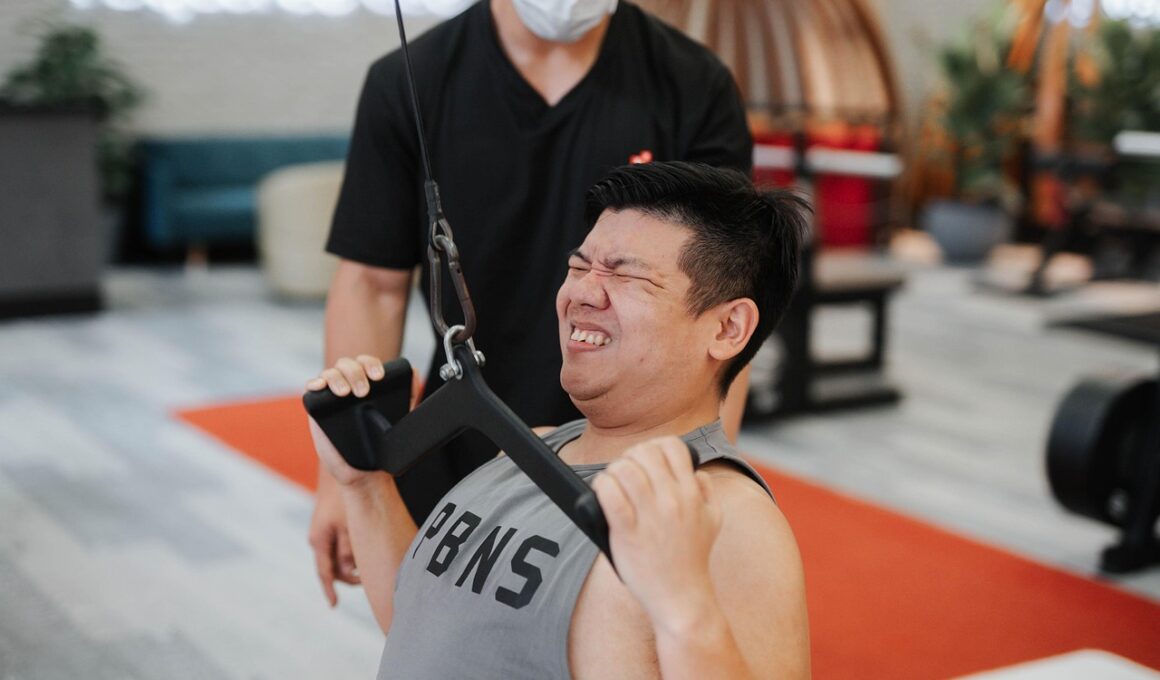Breathwork Techniques in Specialty Personal Training
Breathwork techniques have become increasingly important in the realm of specialty personal training, highlighting the connection between breath and performance. By mastering different breathing methods, athletes can enhance endurance, strength, and brain function. Coaches often utilize these techniques to help clients regulate their emotional states and manage stress during rigorous workouts. Deep diaphragmatic breathing has shown the ability to lower heart rate and reduce anxiety, allowing clients to focus on exercise intensity. In moments of fatigue, integrating breathwork can rejuvenate energy levels, leading to increased performance. Clients often report feeling more centered and mindful, fostering a deeper connection to their bodies and movement. Furthermore, understanding the mechanics of proper breath can improve core stability, enhancing overall alignment and posture during physical activity. Specialty trainers can implement specific breath patterns tailored to various exercises, allowing clients to maximize benefits. Every breath serves as a powerful tool in training, altering mental perspectives and shifting energy. For more information on specific techniques and their impacts, enthusiasts can visit reputable fitness resources and articles.
Incorporating breathwork into strength training is particularly effective. This method cultivates core activation, which forms the foundation for many exercises. When strengthening the core, trainers teach clients to exhale during exertion, which aids in stabilizing the spine and generating power. Furthermore, emphasizing the inhalation phase allows for efficient recovery between sets. Clients learn that the breath serves as a natural anchor, enhancing mental clarity and focus during demanding workouts. Techniques such as box breathing can be particularly impactful; inhaling for four counts, holding for four counts, exhaling for four counts, and holding for another four can effectively ground trainers and clients. Using this method, both can reduce anxiety and improve concentration, particularly before crucial lifts or intense intervals. As clients become more aware of their breathing patterns, they can regulate their heart rates and mobilize their energy more efficiently. Trainers need to create a supportive environment where such techniques can be practiced regularly, as consistency in breathwork practice is key to achieving lasting results.
Breathwork and Flexibility Training
Breathwork also plays a significant role in flexibility training, facilitating deeper stretching and improved mobility. Through mindful breathing, clients can engage their parasympathetic nervous system, which promotes relaxation in their muscles. This allows for a safer and more effective stretching session, reducing the risk of injury. For instance, incorporating breath counts with stretches can enhance the depth of each pose. As clients inhale, they may elongate and deepen their stretch, while exhaling allows for a release of tension. Trainers can also utilize dynamic breath techniques in yoga and pilates, focusing on harmonizing breath with movement. Such alignment encourages clients to move fluidly and remain present, allowing for an enhanced workout experience. Mindful breathwork helps in finding inner calmness, supporting the expansion of one’s range of motion. This holistic approach can address physical imbalances, helping clients achieve symmetrical movement patterns. Over time, clients develop a more profound understanding of their bodies, thereby cultivating a sustainable flexibility practice. Breathwork serves as a bridge between the mental and physical, essential for overall wellbeing in training.
Moreover, breath control can be beneficial in recovery sessions, which are integral to any specialty training program. These sessions allow the body to heal and repair, and breathwork acts as a facilitator for rejuvenation. Deep, slow breathing encourages blood flow, aiding nutrient delivery and waste removal from tissues. Trainers can guide clients in post-workout breath exercises, promoting active recovery by decreasing cortisol levels and supporting the immune system. Techniques like alternate nostril breathing help to balance energy flow and quickly bring the body back to a state of equilibrium. Clients can employ these recovery techniques at home, ensuring they complement their workout regimens. Incorporating a 5-10 minute breath session following workouts can yield significant benefits. Such practices lead to better sleep quality, further enhancing the body’s recovery capabilities. Specialty trainers should emphasize this critical aspect of fitness, equipping clients with effective tools to transition from high-intensity training to restful recovery. Breathwork is not merely an accessory but a necessity for holistic performance outcomes. It enhances not only physical training but also psychological resilience during demanding fitness routines.
Breathwork in Mental Training
Furthermore, breathwork serves as an essential mental training tool in specialty personal training. In high-pressure scenarios, athletes may experience anxiety, potentially affecting performance. Implementing breath control techniques provides clients with strategies for managing stress effectively. Mindful breathing exercises can foster increased self-awareness as clients learn to recognize signs of tension and fatigue. As trainers introduce breath-focused mindfulness practices, athletes can improve their concentration levels, honing their mental fortitude for competition. Failure or success is often determined by mental resilience, making breathwork a vital component in mental conditioning. Techniques such as 4-7-8 breathing, where clientele inhale for four counts, hold for seven, and exhale for eight, significantly help downregulate the nervous system. This method helps to reset emotions, calming the mind before crucial performances. In scenarios demanding quick decision-making, proper breath can also foster clarity and a balanced mindset. Effective mental training includes a robust breathwork component, promoting holistic fitness development. Specialty trainers who advocate for breath awareness provide clients individual growth opportunities, ultimately building strong coaching relationships based on trust and understanding.
Integrating breathwork within specialty personal training aligns with a body-mind approach to fitness. By exploring breath techniques in tandem with physical exercises, trainers can promote a more complete understanding of wellness. Clients often report enhanced motivation and deepened engagement in their practices when breathwork is part of their training regimen. Trainers are encouraged to remain adaptable, discovering which techniques resonate most with individual clients, ultimately personalizing the training experience. Education surrounding breathwork techniques can be crucial; trainers must communicate the benefits effectively while incorporating them seamlessly into various disciplines. This could include strength training, cardiovascular workouts, or yoga and pilates. A workshop or group class dedicated to breathwork could also aid clients in experiencing the collective power of group practice. As clients learn to incorporate breathwork into their routines, trainers can expect improved performance, increased accountability, and deeper connections to their own health. These shifts lead to positive, lasting transformations, highlighting the importance of breath in every facet of fitness journeys. The future of specialty personal training will likely continue to embrace these practices, showcasing a commitment to holistic health and empowerment.
Conclusion: Embracing Breathwork
In conclusion, breathwork significantly enhances specialty personal training, offering benefits across various facets of fitness. From improving physical performance to aiding mental resilience, instructed breath practices have become essential tools for trainers. As clients cultivate these skills, they cultivate a deeper understanding of their bodies and minds, promoting overall wellness. Trainers must realize the transformative potential of integrating breathwork into their personalized training programs. By approaching fitness through a holistic lens, both trainers and clients create a supportive environment for exploration and growth. Therefore, specialty personal training should celebrate breath as both an essential tool and an integral aspect of fitness. Trainers can leverage their knowledge to empower clients, illuminating the path towards improved physical and mental performance. The journey towards wellness transcends mere physicality, encompassing an interconnected approach to mind and body. By embracing breathwork, specialty trainers can forge powerful relationships with clients while promoting long-lasting positive changes. The future of personal training lies in such holistic understandings. Together, trainers and clients can explore the transformative power of breath, empowering individuals to reach their highest potential in their fitness endeavors.
As we advance, it’s crucial to keep the discussion surrounding breathwork alive within specialty personal training communities. Continued dialogue encourages innovation and effectiveness in training protocols. Trainers may choose to gather feedback from clients on their experiences with breath techniques, thus fostering a feedback loop for ongoing improvement. Advanced practices and adaptations can be introduced based on each client’s progress and comfort levels. This collaborative effort allows the enhancement of training methodologies while staying rooted in foundational principles of breathwork. By sharing success stories and challenges, trainers can motivate one another to consistently incorporate breath strategies into their routines. By elevating breathwork’s status within various training regimens, we reinforce its importance. Lifelong learning becomes a vital aspect of being a successful trainer, evolving alongside industry practices. Consequently, trainers should seek professional development opportunities focused on breath techniques and their applications in fitness. These educational pursuits can greatly influence how trainers approach their training practices. In this way, breathwork becomes a shared language among trainers and clients, facilitating dialogue and promoting overall well-being throughout their fitness journeys. Ultimately, the goal remains a more profound connection between body and mind.


